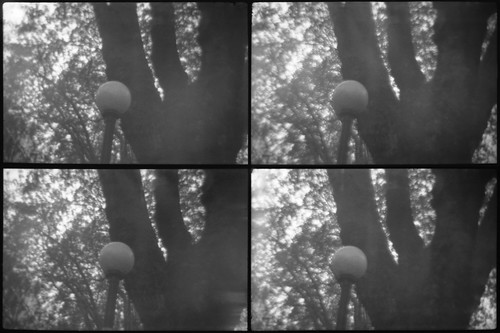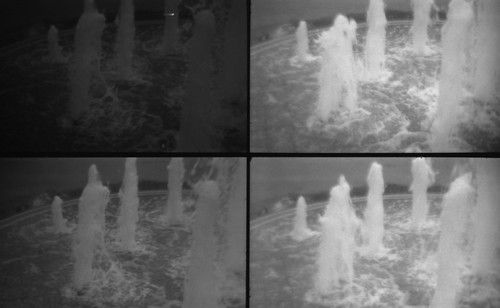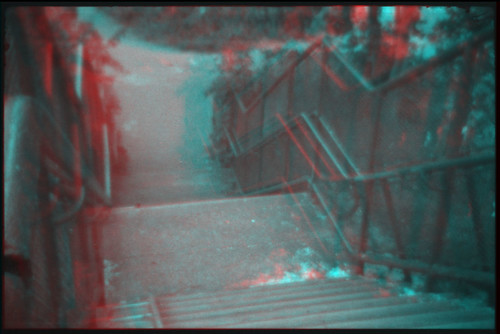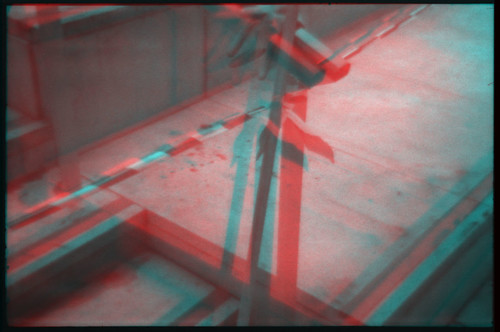 |
| Uboot Action Sampler |
My example of the camera has 'uboot' printed on the back (the downwards pointing arrow on the front appears to be the uboot logo and is also printed on the back); in smaller type it has 'powered by www.lomo.com'; as with a number of cheap plastic novelty cameras, including the similar Action Tracker, the Action Sampler is s typical example of Lomography's modus operandi: take a cheap plastic novelty camera, rebrand it, market it, and sell it for many times its value. This 'uboot edition' was apparently given away free in the early 2000s to promote a social networking website (see this discussion on Flickr); there were a number of variations of the camera, in different colours, some with different coloured filters over the lenses, a flash version, and so on: the Lomography website is currently selling a clear version for £29.
My initial thought was to use the four sequential frames to make short animated loops as GIF files, in part inspired by recent research into early moving images, by the work of Muybridge and Marey, and by reading Rudolf Arnheim (notably, 'The Thoughts that Made the Picture Move’, from Film as Art). Given the very limited parameters of what the camera was capable of, the limit of four frames, I began to think of simple, repetitious cycles of motion that the camera could represent, and might work as a short animated loop. The sequences would have to be circular, not linear, to work as loops, and I thought of some of the ideas behind my piece 'Paper Cinema' and the descriptions of how the movement of the inanimate had fascinated early viewers of cinema at its inception, epitomised in the motion of leaves in the wind. A further example of the movement of the inanimate which is present in many of the Lumiere's early films is water in its various forms: the water from a hose, waves on the surface of the sea, steam rising. In addition, I then thought of visible states which represented binaries, on/off states; all of these subjects would have to be comprehended in less than a second.
As I hadn't shot with the Action Sampler before the start of the #ShittyCameraChallenge, I looked for these subjects with the first roll through this camera, without knowing what to expect in terms of the results other than conceptually what the camera does (I had, of course, seen examples online).
 |
| Action Sampler with Ilford Pan 100 |
 |
| Action Sampler with Ilford Pan 100 |
The best of these images were generally the simplest: it hadn't always been easy to find subjects which fitted with the limitations of the four frames in less than a second, and in addition, the parallax caused by the separate positioning of the four lenses I hadn't really taken into account. This meant that it was not a simple matter of literally stacking the four frames one after the other, but it made more sense to find a focal point to each sequence and align this in each four frames, then crop to a consistent whole, clearly seen in the image below.
This parallax effect is essentially 'wiggle stereoscopy', and, even while I was still shooting the first roll, I thought that it would be possible to make stereo pairs from static scenes. Given the design of the four lenses, to shoot on a single standard 24x36mm frame of 35mm film, there isn't much lens separation, but the parallax is clear when put together as an animated GIF from the shifting position, both horizontal and vertical, as above. I chose some scenes with close subjects contrasting with some form of recession that could give relatively good separation despite the close stereo baseline, and the first image below is perhaps the best demonstration of this; the second image I had intended to make into an animated GIF, but the breeze which had been animating the tape did not sufficiently do so at the point at which I took the photographs, but the tape itself stands out well enough from the background as a stereo anaglyph.
 |
| Stereo anaglyph from two Action Sampler frames |
 |
| Stereo anaglyph from two Action Sampler frames |
Lomography Acton Sampler microsite
Action Sampler on Camera-Wiki
Alfred Klomp's review of the Action Sampler - includes scans of the (2-page) manual









These are great. So glad you got something useable from that piece of plastic! My fav is the plants, but the shimmery water is great too.
ReplyDeleteThanks - and thank you for the donation!
DeleteI have this exact camera from when I signed up to uboot.
ReplyDeleteThey had tried to gain traction in the English market but almost all users were German!
Hey I was wondering if you know how to set this up. Never had a camera before and it came with no instructions!
ReplyDelete